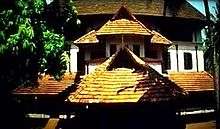Nālukettu
Nālukettu![]()


Thatchu Shasthra, or the Science of Carpentry and Traditional Vasthu, was the governing science in this architectural form. This branch of knowledge was well developed in the traditional architecture of Kerala and has created its own branch of literature known under the names of Tantrasamuchaya, Vastuvidya, Manushyalaya-Chandrika, and Silparatna.
The layout of these homes is simple, and catered to the dwelling of the large number of people usually part of a tharavaadu. Ettukettu (eight halled with two central courtyards) or Pathinarukettu (sixteen halled with four central courtyards) are the more elaborate forms of the same architecture. Every structure faces the sunlight, and in some well designed naalukettu, there is excellent ventilation. Temperatures, even in the heat of summer, are markedly lower within the naalukettu.
The nalukettu and ettukettu buildings must have been inspired from the ancient Chinese house architecture. Kerala had a long and strong history of trade between China.[1]
References
External links
| Wikimedia Commons has media related to Nālukettu. |
- Naalukettu: A Magnificent Tradition of Domestic Architecture
- Naalukettu: A Visual Representation Of The Architecture
- Kerala Nalukettu house plans
- House Architecture
- Route – Trade History between China and Kerala, India: Kerala History